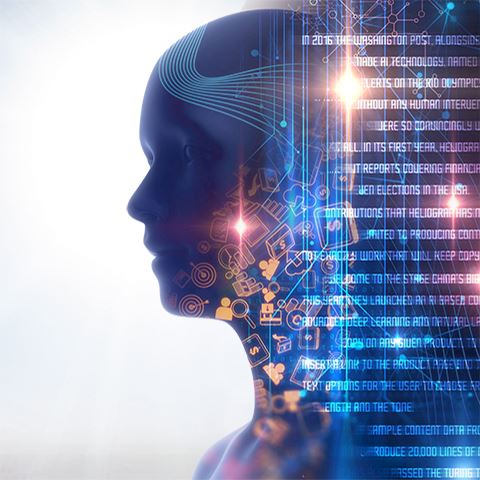
Navigating the rise of technology in construction
In this article we’ll dive into the booming world of smart construction technology, exploring the innovations driving the change and what the future looks like for the industry.

It is certainly no secret that artificial intelligence (AI) is playing an increasingly integral role in our lives – whether it’s at home or at work. With unprecedented levels of investment into various forms of the technology, from start-ups to large corporation funding, this global phenomenon is seeping into every aspect of how we do business. And now, even our beloved craft of copywriting seems in danger of being overtaken by AI.
Simply put, artificial intelligence is human intelligence manifested by a machine. The ability to perceive, understand, learn, problem solve and even, to some extent, the ability to reason, are all essential features of AI.
Taking AI for granted
Within the developed markets, artificial intelligence is already deeply rooted within our everyday lives. So much so that 63% of global consumers (according to a recent report by IBM and DHL) are not even aware that they’re using AI enabled products, services and apps on a daily basis.
Think about the last time you posted a picture on Facebook and it gave you the options of who to tag, this facial recognition software is a form of AI. Or if you asked your Amazon Alexa, ‘Alexa, what’s the weather outside?’ and she replied ‘The weather today is mostly cloudy, with 67% chance of rain’ – this voice assistant feature? Yes, another variant of AI.
So, are AI machines going to take over the world? No.
… well, not yet. But AI is certainly starting to play a role in the workplace. Jobs that are highly repetitive and highly predictable, currently using human intelligence, have the potential to be entirely replaced by automation. In fact, accoring to a report from McKinsey in 2017, up to half of today's work activities could be automated by 2055.
Copy robots in our midst
Over the past few years, the use of AI systems as a means to create copy is appearing more and more.
In 2016 the Washington Post, alongside a team of journalists, started to use their self-made AI technology, named Heliograf, to generate real-time short reports and alerts on the Rio Olympics. Heliograf’s c.300 reports were published, without any human intervention, on the Post’s website and Twitter feed. The posts were so convincingly written, no one twigged it was a machine behind it all. In its first year, Heliograf produced 850 articles for the Post, churning out reports covering financial news, local high-school football games and even elections in the USA.
The contributions that Heliograf has made are certainly noteworthy, but the system was limited to producing content based on data-centric information. Not exactly work that will keep copywriters out of a job.
Then, welcome to the stage China’s biggest online commerce company, Alibaba. This year they launched an AI based copywriting tool which uses more advanced deep learning and natural language processing technology to produce copy on any given product. To create copy, the user simply has to insert a link to the product page and the AI system will offer a multitude of text options for the user to choose from. There’s even the option to adjust the length and the tone.
The tool uses sample content data from Alibaba’s e-commerce sites Tmall and Taobao to produce 20,000 lines of copy a second. If all that isn’t impressive enough, it has also passed the Turing Test - an assessment devised to test whether a machine can exhibit behaviour equivalent to, or indistinguishable from, that of a human. To put it simply; if the machine can fool you into believing that what it is saying was said by a human, it passes.
Room for both
If AI machines, in their relative infancy, are already able to create copy at a speed completely unachievable by humans and to a ‘human’ standard, are copywriters on a road rapidly heading to redundancy?
We don’t think so. Yes, AI systems are successfully being used to produce copy that humans would typically be tasked to do. But this is not a call for panic, rather an opportunity to embrace. For businesses wanting to say essentially the same thing over lots of different channels, it is costly to pay a copywriter to simply adjust text. This is where tools such as Heliograf and Alibaba’s copywriter can pick up the mundane, time-consuming and repetitive work.
What the AI machines possess in speed and efficiency they undoubtedly lack in creativity – the emotion and ability to form a point of view. They simply don’t produce the quality of content anywhere near close to that of a human. And so, by unloading the (arguably) dull work on to machines, copywriters can win back the freedom to be more creative and focus on the interesting, complex and more content-valuable projects.
The presence of AI is well and truly a reality and it is not going to disappear. But rather than being something that should be feared, we see a real value for B2B communications. For copywriting at least, it has the power to take on repetitive work, allowing the humans to add the real value of innovative and creative copy.
If you also believe in the power of people over robots, contact Rachel Arquati to discover how Clear B2B can help you get more out of your copy and content.



In this article we’ll dive into the booming world of smart construction technology, exploring the innovations driving the change and what the future looks like for the industry.

Learn how to use presentation opportunities as an effective lead-generation tool in your trade show activity.

Great marketing success comes from keeping your communications focused, engaging and simple to ‘get’ - but that isn’t always so simple to achieve.

With multiple types of technologies being considered, we bring you a snapshot of alternative fuels and review the most prominent pros and cons for each one.